Emha Ainun Nadjib Kiai Kanjeng Tour the Netherlands
Concerts of Magic and Hope
For the two weeks from 6 – 20 October 2008 Indonesian artist Emha Ainun Nadjib and the gamelan fusion orchestra that he leads, Kiai Kanjeng, have been touring the Netherlands at the invitation of the Hendrik Kraemer Institute and the Bezinningscentrum Protestantse Kerk in the Netherlands. The program was filled with concert performances, seminars, interviews and dialogues with a range of groups and audiences. The program was entitled VOICES & VISIONS: Indonesian Muslim Poet Emha Ainun Nadjib Sings a Multifaceted Society
No stranger to travelling to foreign shores, the group have already toured the UK, Germany, Italy, Australia, Malaysia and other countries. However, this tour was something different. These concerts were filled with magic and hope. Consequently the tour was nothing short of miraculous in terms of what it was able to achieve in the field of human relations. These relations can be said to be inter-faith or inter-cultural or any similar designation but most importantly they were truly humanist. This tour built bridges among communities whose members had been suspicious of one another. It showed the promise of what could be attained when communities work to engage each other, as we saw in the town of Deventer. It provided evidence of the potential for communities to live in harmony, acceptance and tolerance along side each other; different, separate, but one.
For almost a year the management of Kiai Kanjeng had worked to respond to the invitation to visit the Netherlands. There were to be a number of appearances in various cities and towns. Among those behind the invitation were Nelly Van Doren, Ph.D from the Valparaiso University, Indiana, USA and Aart Verbug, a priest and director of the Bezinningscentrum Protestantse Kerk in the Netherlands. Both had spent time in Indonesia and were aware of the work of Emha Ainun Nadjib and KiaiKanjeng in the fields of grass roots activism and the building of inter-faith tolerance. Both could speak bahasa Indonesia. Supporting Emha and Kiai Kanjeng was Ian L. Betts, author of the book Jalan Sunyi Emha (The Silent Path) and a frequent partner in their activities who had previously accompanied the group to Australia and Malaysia as well as its engagements in Indonesia.
On Monday 6 October, 22 members of Kiai Kanjeng including Emha, his wife Novia Kolapaking and Ian L. Betts boarded a KLM flight to Amsterdam, arriving at Schiphol Airport early on Tuesday 7 October. They were met by Aart Verbug and the entire group bussed to its accommodation at Wisma Tamu in Wassenaar, near The Hague. Settling in, a small delegation would soon be ready to meet with H.E. Yusuf Effendi Habibie, Indonesia’s ambassador to the Netherlands. The ambassador fully supported the program and spoke with Emha and the delegation for an hour before they retired to relax before the following day’s full program of engagements.
On Wednesday 8 October Kiai Kanjeng were due to hold a press conference at the Indonesian embassy. This was to be followed by the group’s first performance by the group on Dutch soil. As it turned out, Kiai Kanjeng played first for almost an hour with a powerful medley of Indonesian, Arabic and western songs, accompanied by Emha. The group were note-perfect and the members of the media present appeared dumbstruck by their synchronicity. At one point, during a medley of Indonesian folk songs from Sulawesi, Papua, Sumatra and Java the group rocked seamlessly into John Lennon’s Imagine and Emha, who had been sitting far at the back behind the audience, as if not part of events, was suddenly there at the front and in charge and his rich, strong voice boomed out the song’s verses, causing the audience offer surprised and delighted applause. Clearly something unusual was happening here.
Following the performance Emha was asked to join a panel with Aart Verbug and Dr. Siswo Pramono, LLM, Minister Counsellor for Political Affairs at the embassy. After an introduction by Aart, Emha spoke about the roles he had played in politics during the Indonesian reform era. He spoke about the events that led to the resignation of Suharto, the formation of the fifty-strong reform committee, the meeting of the “eminent nine”. He spoke of Nurcholish Madjid, Amien Rais and many others, of history in the making. Beyond Suharto there was Abdurrahman Wahid and Emha’s work to raise his candidacy as president as well as his work to ease his exit from power. There was his work to achieve the acceptance of presidency of Megawati Soekarnoputri and his work to support the victims of the Sidoarjo mudflow disaster during the current term of President Susilo Bambang Yudhoyono. Emha had been behind all of these political developments, providing important facilitation, mediation and advice.
Finally there was his role in bridging the multitude of Islamic groups in Indonesia. Though well-versed in the Muhammadiyah and Nahdlatul Ulama traditions, Emha has also been instrumental in assisting groups such as Hizbut Tahrir, the Justice and Welfare Party, the Liberal Islam Network (JIL) and even the supporters of Abu Bakr Ba’asyir. This was partly achieved through the Maiyah or gatherings that Emha conducts regularly every month in at least five major cities, and partly through private interface. Most importantly of all, there was a discussion of Emha’s work in the field of inter-faith dialogue, his active and deliberate engagements with Christian groups in Indonesia and his championing on the Ahmadiyah sect. Emha put forward a concept of the Madania society, referring to an idyllic society envisaged in Medina by the Prophet Muhammad in the seventh century, in which all groups are guaranteed their rights. Inter-faith dialogue was to be a key component of this tour. Dr. Siswo Pramono then addressed the audience, describing previous attempts by the embassy to conduct inter-faith activities. He said that Emha’s remarks had been the most important comments he had heard in five years. The audience, largely press, were then invited to put their questions. There was a further discussion of Emha’s work in response to the questions and a number of journalists said that they would be attending the events and concerts that had been arranged.
As soon as the press conference was over the group had to pack in order to move on to the next performance, which was to be at the Triumfaret Church in The Hague. The church is open daily and attracts many visitors to its art exhibitions and cultural events. The audience was not a large one but it was a large stage and Kiai Kanjeng had the space to stretch out and allow their music to fill the hall. The performance was a great success. Again, the group played with musical forms, swinging from playful renditions of Sinatra’s “love” to “Kalimah”, a song originally by the Lebanese artist Majdah Rumi. Though Emha led many of the more epic numbers, Novia Kolapaking really stood out this afternoon. Her performance of Kalimah, as it swept dramatically though several changes in mood, emotion and tempo, was tremendous and brought shocked sighs and gasps from the audience. One man found himself spontaneously in tears, yet breathlessly elated. The group also played a couple of Dutch songs, teasing the audience playfully, while between songs Emha offered dialogue and anecdotes, translated into Dutch by Aart Verbug. He talked about love and relationships, using simple analogies from Indonesian cultural contexts such as the process from “padi” to “un-husked rice” to “rice” and then “cooked rice”, ready to eat. He talked about relations between peoples of different faiths and different countries. He described Islam as the “kitchen” in which the rice was cooked rather than the rice itself. He talked of Islam as the “input” and of the good that can be achieved among people as the “output.” The entire venue took on a human warmth and Emha told the audience that they had “become part of a special place in my heart. That is the way we say I love you”, and that the objective of Kiai Kanjeng’s tour was to “put the whole world in our heart.”
To be continued…
For the two weeks from 6 – 20 October 2008 Indonesian artist Emha Ainun Nadjib and the gamelan fusion orchestra that he leads, Kiai Kanjeng, have been touring the Netherlands at the invitation of the Hendrik Kraemer Institute and the Bezinningscentrum Protestantse Kerk in the Netherlands. The program was filled with concert performances, seminars, interviews and dialogues with a range of groups and audiences. The program was entitled VOICES & VISIONS: Indonesian Muslim Poet Emha Ainun Nadjib Sings a Multifaceted Society
No stranger to travelling to foreign shores, the group have already toured the UK, Germany, Italy, Australia, Malaysia and other countries. However, this tour was something different. These concerts were filled with magic and hope. Consequently the tour was nothing short of miraculous in terms of what it was able to achieve in the field of human relations. These relations can be said to be inter-faith or inter-cultural or any similar designation but most importantly they were truly humanist. This tour built bridges among communities whose members had been suspicious of one another. It showed the promise of what could be attained when communities work to engage each other, as we saw in the town of Deventer. It provided evidence of the potential for communities to live in harmony, acceptance and tolerance along side each other; different, separate, but one.
For almost a year the management of Kiai Kanjeng had worked to respond to the invitation to visit the Netherlands. There were to be a number of appearances in various cities and towns. Among those behind the invitation were Nelly Van Doren, Ph.D from the Valparaiso University, Indiana, USA and Aart Verbug, a priest and director of the Bezinningscentrum Protestantse Kerk in the Netherlands. Both had spent time in Indonesia and were aware of the work of Emha Ainun Nadjib and KiaiKanjeng in the fields of grass roots activism and the building of inter-faith tolerance. Both could speak bahasa Indonesia. Supporting Emha and Kiai Kanjeng was Ian L. Betts, author of the book Jalan Sunyi Emha (The Silent Path) and a frequent partner in their activities who had previously accompanied the group to Australia and Malaysia as well as its engagements in Indonesia.
On Monday 6 October, 22 members of Kiai Kanjeng including Emha, his wife Novia Kolapaking and Ian L. Betts boarded a KLM flight to Amsterdam, arriving at Schiphol Airport early on Tuesday 7 October. They were met by Aart Verbug and the entire group bussed to its accommodation at Wisma Tamu in Wassenaar, near The Hague. Settling in, a small delegation would soon be ready to meet with H.E. Yusuf Effendi Habibie, Indonesia’s ambassador to the Netherlands. The ambassador fully supported the program and spoke with Emha and the delegation for an hour before they retired to relax before the following day’s full program of engagements.
On Wednesday 8 October Kiai Kanjeng were due to hold a press conference at the Indonesian embassy. This was to be followed by the group’s first performance by the group on Dutch soil. As it turned out, Kiai Kanjeng played first for almost an hour with a powerful medley of Indonesian, Arabic and western songs, accompanied by Emha. The group were note-perfect and the members of the media present appeared dumbstruck by their synchronicity. At one point, during a medley of Indonesian folk songs from Sulawesi, Papua, Sumatra and Java the group rocked seamlessly into John Lennon’s Imagine and Emha, who had been sitting far at the back behind the audience, as if not part of events, was suddenly there at the front and in charge and his rich, strong voice boomed out the song’s verses, causing the audience offer surprised and delighted applause. Clearly something unusual was happening here.
Following the performance Emha was asked to join a panel with Aart Verbug and Dr. Siswo Pramono, LLM, Minister Counsellor for Political Affairs at the embassy. After an introduction by Aart, Emha spoke about the roles he had played in politics during the Indonesian reform era. He spoke about the events that led to the resignation of Suharto, the formation of the fifty-strong reform committee, the meeting of the “eminent nine”. He spoke of Nurcholish Madjid, Amien Rais and many others, of history in the making. Beyond Suharto there was Abdurrahman Wahid and Emha’s work to raise his candidacy as president as well as his work to ease his exit from power. There was his work to achieve the acceptance of presidency of Megawati Soekarnoputri and his work to support the victims of the Sidoarjo mudflow disaster during the current term of President Susilo Bambang Yudhoyono. Emha had been behind all of these political developments, providing important facilitation, mediation and advice.
Finally there was his role in bridging the multitude of Islamic groups in Indonesia. Though well-versed in the Muhammadiyah and Nahdlatul Ulama traditions, Emha has also been instrumental in assisting groups such as Hizbut Tahrir, the Justice and Welfare Party, the Liberal Islam Network (JIL) and even the supporters of Abu Bakr Ba’asyir. This was partly achieved through the Maiyah or gatherings that Emha conducts regularly every month in at least five major cities, and partly through private interface. Most importantly of all, there was a discussion of Emha’s work in the field of inter-faith dialogue, his active and deliberate engagements with Christian groups in Indonesia and his championing on the Ahmadiyah sect. Emha put forward a concept of the Madania society, referring to an idyllic society envisaged in Medina by the Prophet Muhammad in the seventh century, in which all groups are guaranteed their rights. Inter-faith dialogue was to be a key component of this tour. Dr. Siswo Pramono then addressed the audience, describing previous attempts by the embassy to conduct inter-faith activities. He said that Emha’s remarks had been the most important comments he had heard in five years. The audience, largely press, were then invited to put their questions. There was a further discussion of Emha’s work in response to the questions and a number of journalists said that they would be attending the events and concerts that had been arranged.
As soon as the press conference was over the group had to pack in order to move on to the next performance, which was to be at the Triumfaret Church in The Hague. The church is open daily and attracts many visitors to its art exhibitions and cultural events. The audience was not a large one but it was a large stage and Kiai Kanjeng had the space to stretch out and allow their music to fill the hall. The performance was a great success. Again, the group played with musical forms, swinging from playful renditions of Sinatra’s “love” to “Kalimah”, a song originally by the Lebanese artist Majdah Rumi. Though Emha led many of the more epic numbers, Novia Kolapaking really stood out this afternoon. Her performance of Kalimah, as it swept dramatically though several changes in mood, emotion and tempo, was tremendous and brought shocked sighs and gasps from the audience. One man found himself spontaneously in tears, yet breathlessly elated. The group also played a couple of Dutch songs, teasing the audience playfully, while between songs Emha offered dialogue and anecdotes, translated into Dutch by Aart Verbug. He talked about love and relationships, using simple analogies from Indonesian cultural contexts such as the process from “padi” to “un-husked rice” to “rice” and then “cooked rice”, ready to eat. He talked about relations between peoples of different faiths and different countries. He described Islam as the “kitchen” in which the rice was cooked rather than the rice itself. He talked of Islam as the “input” and of the good that can be achieved among people as the “output.” The entire venue took on a human warmth and Emha told the audience that they had “become part of a special place in my heart. That is the way we say I love you”, and that the objective of Kiai Kanjeng’s tour was to “put the whole world in our heart.”
To be continued…

































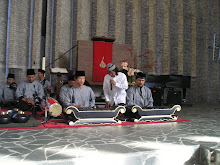
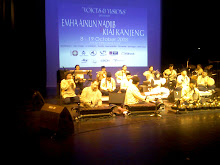

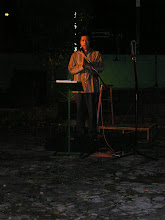



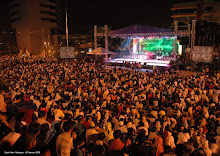
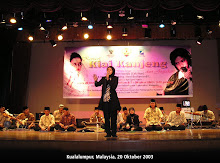
.jpg)






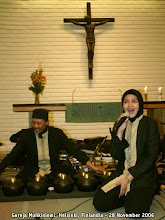.jpg)

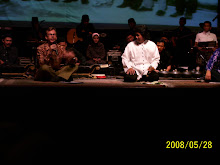.jpg)

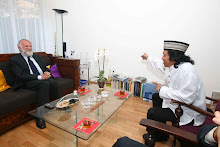
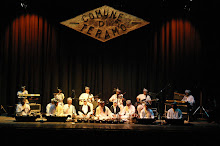




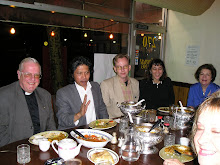


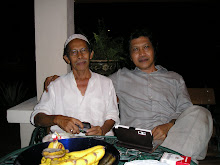
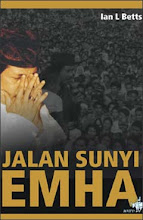
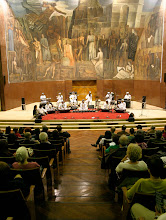
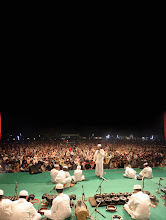

No comments:
Post a Comment